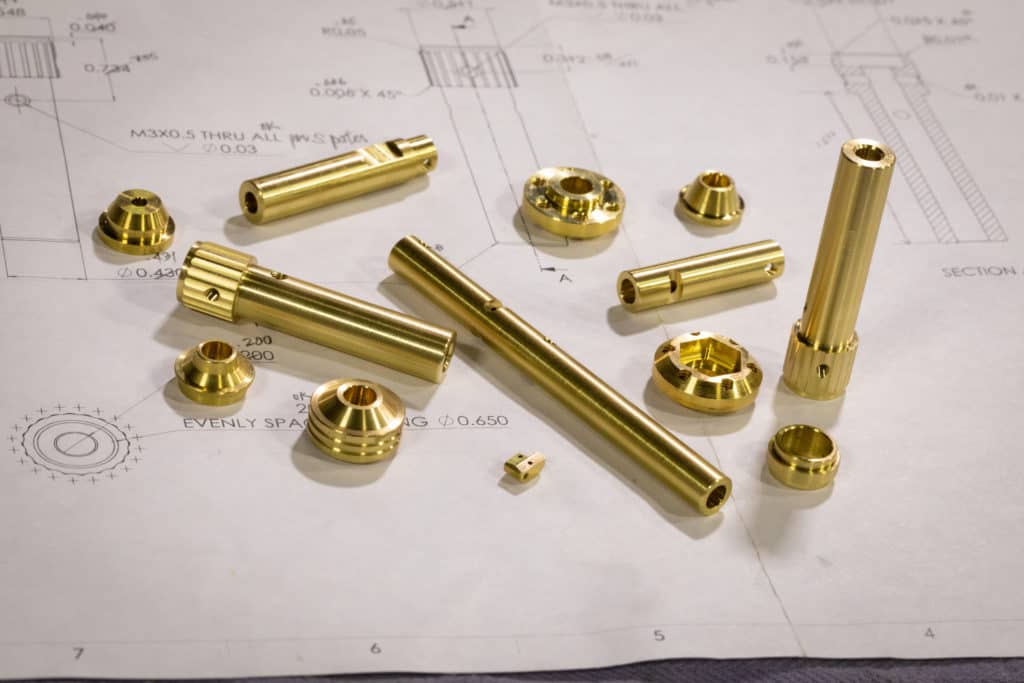SPR already knew from working with customers in the aerospace and medical industries that brass offers numerous advantages, and several stood out on this project in particular. With high-speed machining, brass made drilling deep holes much faster, improved accuracy and extended tool life throughout long production runs. Brass also made deburring the part much easier than it would have been if the part had been made from stainless steel or steel. Additionally, brass required less machining force than steel, which reduced machine and tool wear and produced less deflection at higher speeds. And because brass scrap holds up to 90% of its value, SPR could recoup some of its material costs through chip recycling.
The part itself marked a departure from SPR’s typical workflow and therefore offered an additional challenge. SPR co-founder and vice president Scott Pater raced off-road remote control (RC) cars with a friend who had begun marketing a reengineered RC part to hobby shops. Pater was able to convince his friend to choose SPR as his vendor instead of one in China, in part to avoid a months-long wait for shipments. Pater also noticed that when the part was made from 12L14 steel, it didn’t react well to exposure to the elements, as corrosion and swelling made it difficult to remove once it was in use.
One alternative was to produce the part from aluminum. Although that solved one problem – corrosion – it created another, because aluminum lacked the strength and weight for stability in a small vehicle with a low center of gravity. Brass solved both problems and added several advantages – both in aesthetics and in processing. First, brass didn’t produce the dangerous strings of long bird’s-nest chips that other materials created, especially in machining the part’s nearly 4″-long drilled-through hole. Second, brass made the part look better to customers and reinforced SPR’s commitment to provide high quality with visual appeal.
 So brass offered winning attributes before full part production even began – and those advantages stacked up further through optimization of machining parameters. Our other partner in the project, Cincinnati-based firm TechSolve, which provides machinability evaluation testing services, worked directly with SPR to capture a baseline and then implement process improvements through extensive expertise in machining and materials. In exchange for allowing TechSolve to guide SPR’s production parameters, SPR would gain an in-depth analysis of every aspect of the part’s requirements.
So brass offered winning attributes before full part production even began – and those advantages stacked up further through optimization of machining parameters. Our other partner in the project, Cincinnati-based firm TechSolve, which provides machinability evaluation testing services, worked directly with SPR to capture a baseline and then implement process improvements through extensive expertise in machining and materials. In exchange for allowing TechSolve to guide SPR’s production parameters, SPR would gain an in-depth analysis of every aspect of the part’s requirements.
Prior to optimization, cycle time ran six minutes and 17 seconds per part, or 76 units per eight-hour shift, despite all the efficiencies of a seven-axis Swiss-style Ganesh Cyclone GEN TURN 32-CS CNC lathe with dual 6,000-rpm spindles, 27 tools, linear ways and a 12-foot hydrostatic bar feeder, which Pater acquired explicitly for this project. The initial process required turning, ball milling, drilling numerous deep holes and boring out a bearing surface in the inner diameter.
After SPR implemented TechSolve’s process improvements, cycle time dropped by over 60% to two minutes and 20 seconds, and parts per shift skyrocketed to 191. The high-speed machining capabilities of brass enabled SPR to run aggressive metal removal rates for long production periods with little penalty in tool life. Additionally, SPR was able to substitute a broaching process for ball milling, ganging up parts and machining five slots at once, which they couldn’t do with stainless steel or steel. With a carbide drill for pecking, more-aggressive feeds and depths, fewer retracts, and an increased depth of cut for roughing, SPR saved still more time. Additionally, balancing the workload between two spindles increased throughput because two processes could run simultaneously.
All told, the experience offered great benefits. We saw yet another practical confirmation of the advantages of working with brass on modern high-speed equipment, including reduced cycle times, successful use of more-aggressive machining techniques and increased scrap value. At the same time, SPR Machine gained useful insights it can apply to other current and future projects. If you’re considering a move from steel, stainless steel or other metals to brass for part optimization and have questions, let us know how we can help.


Recent Comments